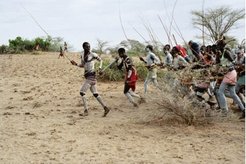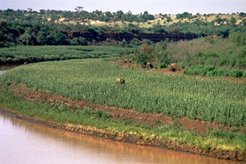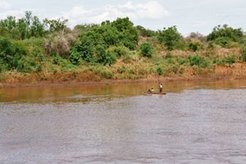The Aedamo of the Karà Rhetoric in social relations, conflict and integration on the Lower Omo

This project explores the ways in which the Karà, a political body of 1,400 people living in the South Omo Zone of Ethiopia, rhetorically enact and manage social relations both within the population and between the group and its cultural neighbors. Fieldwork was done from Feb. 2006 to Feb. 2007, building on several brief earlier visits to Karà, and was characterized by an oscillating movement from participant observation on the Lower Omo to extended discussions with selected partners at the South Omo Museum and Research Center in the regional capital.

Internally, the Karà population is just as ethnically diverse as the South Omo region at large, which is said to be the home of sixteen “ethnic groups”. Karà can be “true Karà”, Gomba, Bogudo, Nyangatom-Karà, Moguji or belong to different ascribed categories still, and the behavior and status of individuals vis-à-vis one another is based on a wide range of quotidian and ritual norms and expectations. However, these practices are not “just there”, but they are, in a language of claims, constantly negotiated, criticized, and challenged. This most visibly affects arenas such as the division of labor, land-holding, commensality and privileges of exogamy. Beyond this tendency towards ethnic differentiation there are other dynamics of a similar schismogenetic form which take up much place in Karà social life and discourse: divisions between age-sets, settlement sections, villages, clans, lineages, and others. Counter-intuitively, differentiation seems a cultivated way of life even though the size of the group makes it impossible for any two individuals to not have a multiplex relationship.
Accordingly, I describe processes from a rhetorical perspective, which looks not at motives for instigating or escalating schisms so much as at the persuasive practices people seem to constantly engage in. As a heuristic device, and to add a second level to the rhetorical analysis, the different grounds on which the differentiations are based are described in terms of the classical rhetorical tropes irony, simile, metonymy, and metaphor.

In order to ground this frame which uses the formal tool kit of rhetoric for a translation of practice, I also attend to several local concepts which permeate social life and to which it always refers back: poramo and k’aiss, pride and taboo, ashka and sessa, making something right and spoiling it, and finally aedamo, the all-encompassing claim of mutuality, equality, and positive cooperation, but seen in a certain light also the god term (Burke) in whose name a social order is imposed which grants certain privileges to “true Karà” at the expense of everybody else; a pax romana in miniature.
The analysis of social relations is extended in that the thesis also addresses the ways in which Karà deal with their cultural neighbors, specifically the Hamar, Banna and Bashada who live in the hills to the East, the Dassanetch in the South, the “penetrating” highland Ethiopians, and most of all the Nyangatom to the East, on the other side of the Omo River, a rising power in this “tribal zone”.
During my fieldwork in 2006/07, Karà and Nyangatom repeatedly met on the battlefield (the banks of the river), as well as in various sites for conciliation and peace talks. In analyzing this segment of a long joint history, I provide an extended example of how the position of the two groups vis-à-vis one another is constantly renegotiated in different arenas, from private discussions within a household to government-sponsored days-long mediatory meetings. Rhetoric, as the way in which power is created and exerted in the definition of the situation, and the analysis of the corresponding language of claims, is the key to the dynamics between these groups and other “tribal”, state or non-state actors.


